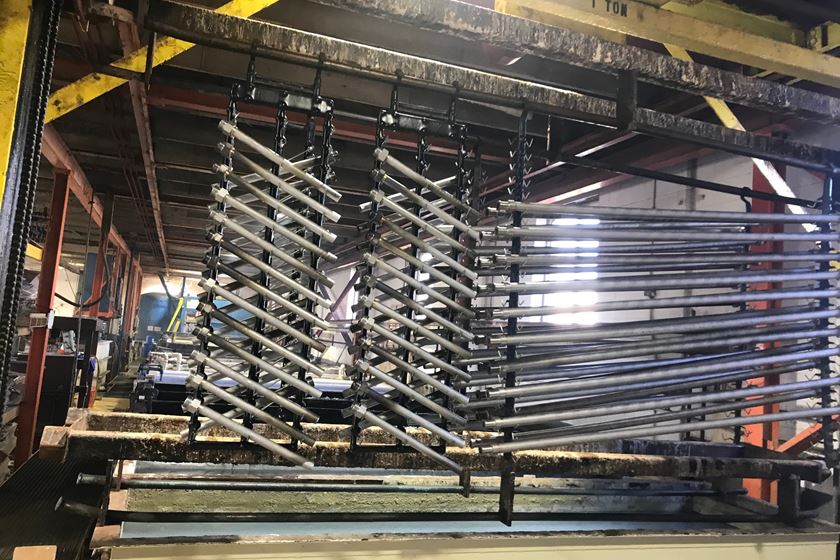Improving the Life of Tanks and Liners
Maintenance of aging plants and equipment is a controllable expense, but only if you are proactive.
The greatest threats facing the finishing industry today are aging plants and equipment, workforce changes, legal and regulatory costs and faulty decision-making models.
Almost 75 percent of U.S. plants are over 20 years old. As equipment ages, downtime increases, and the true cost of downtime is more than just lost production. Without a good handle on the true cost of downtime, decisions are flawed. Most factories lose 5 to 20 percent of production capacity from downtime. Eighty percent of plants can’t estimate the cost of downtime accurately, with many underestimating by 200 to 300 percent. Without accurate numbers, how do you know you are making the right repair or replacement decisions?
Featured Content
Maintenance is a controllable expense, but for the proactive. Research puts maintenance costs at 9–30 percent of the cost of goods sold at a typical process plant, and 4–8 percent per year of the replacement value of the process plant itself.
While it may be wise to rely on redundant equipment, like spare tanks, to maintain production reliability, it’s best to have a long-lasting, affordable solution. Some rely on a supplier’s guarantee. But what is the purpose of a short guarantee for a tank expected to be in service for years? Decisions should consider total cost of ownership.
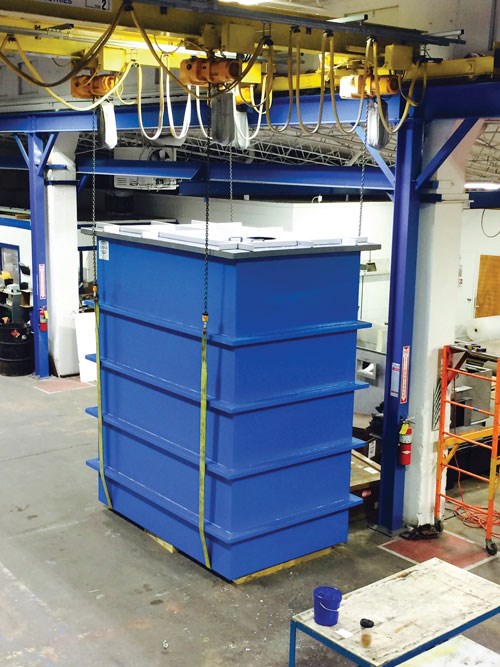
Much of the process industry relies on plastic tanks or on plastic linings or liners in steel tanks or concrete pits.
Causes of Premature Failure
The most common causes of premature failure are improper surface preparation, a bad batch of material, improper application, poor specifications, improper design, faulty inspection and equipment malfunction.
The common denominator is people. The key to avoiding failures is to develop and follow procedures that anticipate and address common human mistakes.
The most important property of any coating or lining system is adhesion to the substrate. Proper surface preparation is critical. When applied to concrete, it is important to check for moisture content and moisture vapor transmission. The surface must be free from contaminants and laitance, loosely adhering concrete and dust, and oil and grease must be removed. Experts note that abrasive blasting does not remove oil and grease or soluble salts.
Tanks are used throughout industry for storage of liquids. The familiar round tanks serve this function well. The process industry has special requirements. Rectangular tanks are common, often with special features such as sloping bottoms, or fittings.
Much of the process industry relies on plastic tanks or on plastic linings or liners in steel tanks or concrete pits. Linings differ from liners in that linings are bonded to the tank’s surface, while liners are free standing within the tank. Linings and liners offer a long, reliable service life and are more economical than most alternatives.
Flexible PVC
Vinyl (flexible PVC) is a mainstay of the industry because it bonds well (if the surface is properly prepared and primer and adhesive specifications are followed) and offers long-term thermoplastic weld reparability. Although vinyl is flexible and tough, damage can occur where parts or equipment repeatedly contact the liner surface. Examples include abrasion, cuts, extreme impact and so on. Bumpers or even acid bricks may be used to protect the liner in those situations.
More exotic fluoropolymers such as polyvinylidene fluoride (PVDF) are also available. They offer resistance to a wider range of materials including organic solvents, and can be used at higher temperatures.
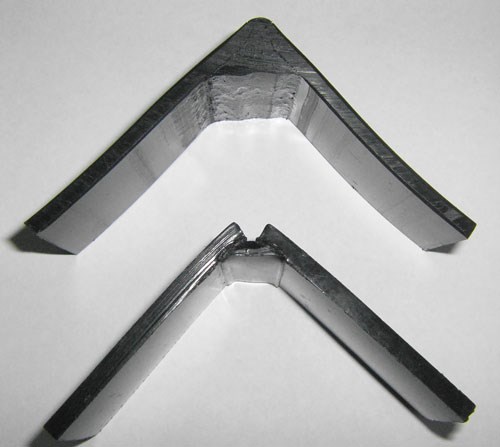
The improved, high strength extrusion weld is shown as corners are a common weakness in lined tanks.
Rubber linings have long been used in industry. These linings are installed by applying sheets of rubber compound to the tank surfaces and then vulcanizing in place, usually by the application of steam heat under pressure in an autoclave. The lining may be repaired by similar application of heat or chemical curing agents. Additives in the compound enable adjustment of the hardness and flexibility of the cured rubber. The cumbersome curing conditions limit utility in many process situations. Most users have switched to synthetics due to the conveniences offered by thermoplastic welding, and some continue to use rubber linings, which are even more difficult to repair.
Lead is a traditional lining material, especially for acids. Lead-lined wooden tanks once were common, but because of the development of modern alternatives, difficulty of repair and toxicity issues now make lead linings a rarity.
Thermal expansion stresses the plastic, so for the best results, tank design must account for expansion. Tensile strength is a measure of a product’s mechanical strength. Weaker materials can be accommodated with increased wall thickness.
Some tanks may be successfully protected with coatings, but linings or rigid plastic liners offer a much thicker barrier layer and longer service life in many applications. For an immersion application, a typical coating is a minimum of 0.76 millimeters (30 mils or 0.030 inches) thick and a typical bonded PVC lining is 4.8 millimeters (0.188 inches) thick.
According to a survey, customers ask for seamless linings, easier detection of leaks, increased service life, monitoring systems, lower cost and improved shock resistance. Liner technology continues to move toward those goals.
A traditional wisdom has grown up about tank liners: They are thought to be commodities. All are alike. Hence, buyers tend to buy on price, overlooking the cost of downtime. However, one must be careful about lowball bids based on use of inferior materials and/or methods.
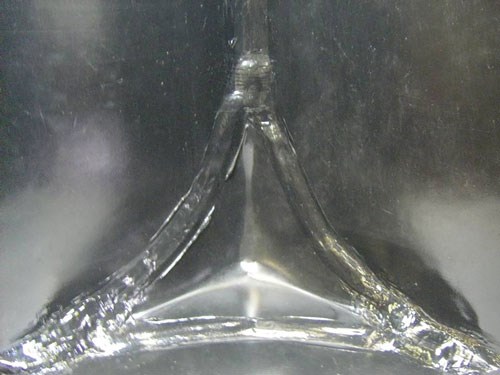
Welding the three intersecting seams has been difficult. The problem is resolved by welding a molded insert into the corner.

A typical installation using extrusion welding.
Plastic Tanks
Plastic tanks, often fabricated from plastic sheets, are popular due to their low cost. Steel frames are often used to provide strength and rigidity. The steel can be enclosed in plastic to protect against corrosion or rusting, but differing rates of thermal expansion can introduce stresses and cracking. Similarly, special tank shapes may introduce stresses which pose design issues.
Polypropylene (PPL) is an economical, yet flammable, material of construction. Of 30 plastics tested, PPL was rated worst as a fire hazard. Once ignited, PPL burns vigorously and up to three times hotter than wood or paper. Temperatures up to 2000°F are reached, sufficient to weaken steel and collapse buildings. Firefighting is made more complex by the presence of hazardous materials. Some plants have been a total loss.
Over a 10-year period, FM Global reported 34 fires in heated plastic tanks. The average cost per incident is now $2.2 million. Immersion heaters have been implicated, but many are caused by other electrical components. Fire retarded grades of polypropylene are known, but have not proved suitable in process tanks.
Homopolymer PPL is also rather brittle and may crack upon impact. Copolymer PPL is more resistant to cracking, but is far more difficult to weld.
Rigid PVC offers excellent fire properties. It is slow to ignite and the flame spread is slow. When the flame source is removed, PVC ceases to burn. Tests have shown that burning polypropylene releases 14 times more heat than PVC. However, not all PVC is created equal. High performance grades and more flexible grades are available when the application requires it.
CPVC is the next step up from PVC. It can be used at higher temperatures and higher pressures than PVC. Due to its higher chlorine content, CPVC also offers still more resistance to fire.
“Fiberglass” tanks, or more correctly tanks constructed of fiberglass reinforced composites, can be suitable when properly matched to the materials to be contained. FRP is brittle and must be maintained by periodically applying topcoats, another source of downtime. Steel tanks with linings offer a longer service life with fewer problems.
Tank Linings
Lined tanks are widely used in the finishing industry—especially for corrosives. The lining protects the tank from corrosion and the tank contents from contamination, and the substrate provides structural integrity. In electroplating, the lining also provides electrical insulation.
For the best results, the steel tank is blasted or the concrete etched before the lining is bonded to the substrate with a suitable adhesive. Bonding prevents rusting and avoids stress crack failures from wrinkles in drop-in bag liners. Plastic welding then seals the seams and corners. Improved fabrication techniques reduce weld failures and increase strength. Ownership costs are lower over the life of the tank.
A survey noted some concerns regarding bonded PVC linings: repairs require outside services, disposal of used lining material, leaks from pinholes and weld failure, separation of the bonded liner from the substrate, old linings that have started to leak or crack and pitfalls of AC high voltage testing.
The industry continues to develop to provide better performance.
A newly deployed extrusion welding is used to seal seams and infuse molten material into the steel corners. The result is a much stronger weld that is more tolerant of stresses, reducing the probability of leaks and increasing service life. In addition, if a leak occurs, solution does not flow behind voids or channels present with conventional corner and seam strip welding.
Extrusion welding offers additional advantages, fully melting the welding rod resulting in a homogenous weld with fewer stresses. The weld is formed in a single pass, further reducing stresses introduced by the multiple passes common in traditional hand welding. This weld is faster and is less sensitive to surface oxidation.
Corners are a common weakness in lined tanks and welding the three intersecting seams has been difficult. The problem is resolved by welding a molded insert into the corner.
Another improvement is the use of radio frequency (RF) machine welding to make full panels for the walls and bottom. If the tank is very large, large sub-panels are joined by skived edges (to avoid entrapped air, similar to rubber lining joints) with overlap extrusion welds. The goal is to eliminate hand welds with seam strips in immersion service.
Bag Liners
“Bag” liners, a low-cost solution to a leaking tank, are fabricated from flexible plastics with RF welded seams. The liner relies on the tank substrate to support the load. The liner must be fitted carefully to avoid wrinkling or stretching as the tank flexes under load. Stress points can cause leaks, which can be difficult to find and repair. The liner may float and move into the working area. However, inspection of steel and weld integrity may not occur when dropping-in a bag liner. Rusting behind the liner may not be inhibited and corrosion from previous leaks may continue unabated.
Do bag liners really save money? Experience indicates they are not a substitute for bonded liners and should be considered a temporary remedy.
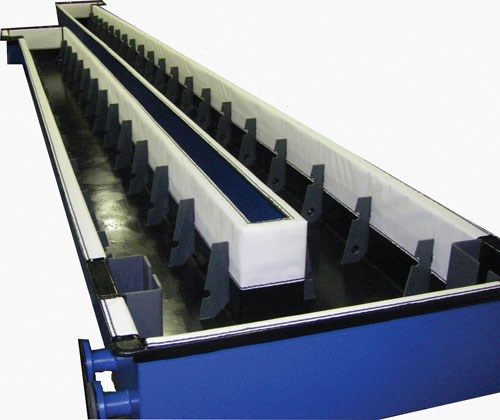
A typical hard chromium plating tank with PTFE skirting.
Rigid Drop-In Liners
Rigid liners may be fabricated from heavier plastic sheets, typically from PVC, CPVC, CoPPL or PVDF. Some suppliers assemble “stick-built” liners within the tank, but this only causes weak, surface welds. In-place assembly can result in buckling (due to thermal expansion in heated tanks), stress cracking and cracked welds.
Assembly in the shop enables the use of plastic welding with 90° thermally-formed, machine bent, rounded corners with machine pressure butt-welded side walls for maximum strength and integrity. The sidewall/bottom joint is a routed mechanical lock-in with machine extrusion welding. Molded corner inserts enable continuous extrusion welding in the problematic inner corners.
To provide double and maximum solution containment, a rigid PVC drop-in liner may include bonded vinyl on either the inside or outside of the rigid shell. A conductive bonding adhesive with a ground connection enables leak detection, permeation monitoring or DC spark testing.
Liners must be undersized to enable thermal expansion and the walls must be supported in void areas to accommodate the load of a full tank. A bumper system may be placed under the liner for absorbing shock. Properly made rigid liners provide excellent service life and are stronger and more resistant to mechanical damage.
Tradition dictates that new tanks or liners must be leached before filling with process solution. This may not be the case with all materials and may be a cost to avoid, if one can safely do so.
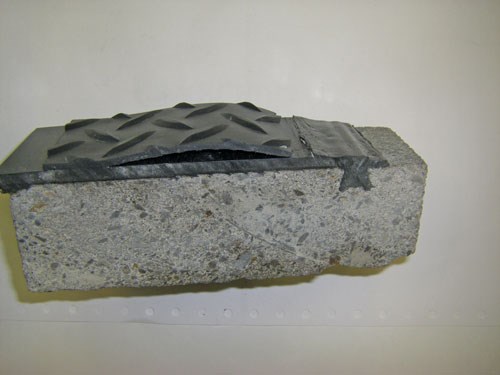
Fig 7: A concrete anchoring technique using an inverted V-notch cut into the concrete. Linings can be secured by infusing weld plastic into the notch essentially welding the lining to the concrete.
Spark Testing / Leak Detection
In an era of strict attention to the environment and especially ground water contamination, early detection of leaks is important when handling toxic materials. In new construction, double bottom tanks and/or secondary containment are now common. Prompt detection of leaks enables repair before the damage becomes extensive.
Dielectric testing, usually called “spark testing,” is traditionally used to detect pin holes in tank linings. Leaks are found by a point source of voltage applied across the liner. Sparking occurs when a gap in the liner enables the passage of current to the ground (conductive substrate). One limitation is that heat from the arc can burn holes in the tank liner. In addition, the tank must be dry to avoid inaccurate readings.
For thin coatings, a battery-operated wet sponge tester is grounded to the substrate and an alarm sounds if a circuit is created, such as when moisture goes through a pin hole or holiday. Although effective, this method is time consuming and requires wetting the entire tank surface one small section at a time. For thicker plastic or rubber linings, high voltage AC spark testers are commonly used. Small handheld models may not be calibrated for the liner material and its thickness, relying solely on the skill of the operator to rapidly test for leaks without doing damage. Modern DC testers can automatically adjust the test voltage to the liner and signal leaks with alarms as well as by sparking. Newer models reduce voltage as soon as the circuit is created to minimize damage.
Many believe spark testing doesn’t work on lined concrete tanks. Contrarily, DC spark testing is effective. A nail driven into the concrete exterior serves as the ground contact. A second nail contact signals sufficient moisture in the concrete to permit testing.
New technology can locate leaks electronically without draining the tank, greatly reducing the time needed to check for leaks. Frequent monitoring then becomes less of a hassle. Leaks can be detected sooner before damage becomes extensive.
Cathodic protection is a proven technology for protecting ductile pipelines and steel tanks and has been used to protect lined electroplating tanks. By applying DC potential, the steel tank is protected from corrosion and a pinhole leak is plated again and again. This can result in a sizeable deposit of metal, sometimes called a “tree,” which can create plating problems and eventually get in the way of the parts, though plating exposed steel may be preferable to a corroded steel leak. Modern instrumentation can find this liner breach and enable repair on a scheduled basis.
Innovations
An example of design improvements is the use of PTFE or PVDF skirting to extend the service life in PVC or CPVC lined tanks used in hard chromium plating. The skirting protects from cracking usually observed at the air interface.
Another innovation is a concrete anchoring technique using an inverted V-notch cut into the concrete. Linings can be secured by infusing weld plastic into the notch essentially welding the lining to the concrete.
Similarly, fittings are difficult to protect in lined tanks because they often require hand-welded lining. Pumping over the side is a preferred design feature that avoids the problem of protecting fittings.
Techniques have been developed to detect leaks in double walled and/or bottom tanks. By filling the outer tank with water to a height of about 5 centimeters (2 inches) above the bottom of the inner tank, leaks are detected by measuring current flow in the water. The water also prevents an inner tank leak from rushing acid into an air void that wants to be filled. The water provides another level of risk mitigation thanks to the laws of fluid dynamics.
The ideal supplier works with you as a partner, and their purpose is to meet your need with the best overall solution. Their experience is a major asset in helping you select the right material for your application and install it correctly.
Originally published in the November 2015 issue.
RELATED CONTENT
-
2020 Vision: The Future of Coatings
The year 2020 will be here before you know it, signaling the beginning of a new decade and bringing changes to the world as we know it.
-
Salt Spray Vs. Cyclic Corrosion Tests
Joseph Subda, ecoat specialist for Axalta Coating Systems, explains the difference between these two corrosion resistance tests.
-
Measuring the Surface Area of Fasteners
How do you measure the surface area of a threaded fastener? How much coating would you put on it? How thick of a coating? What about non-threaded fasteners? The U.S. Department of Agriculture’s Forest Service, of all people, may have come up with the solution for those pondering how to coat sometimes-difficult small pieces using computer imaging and software to compute the area.
















